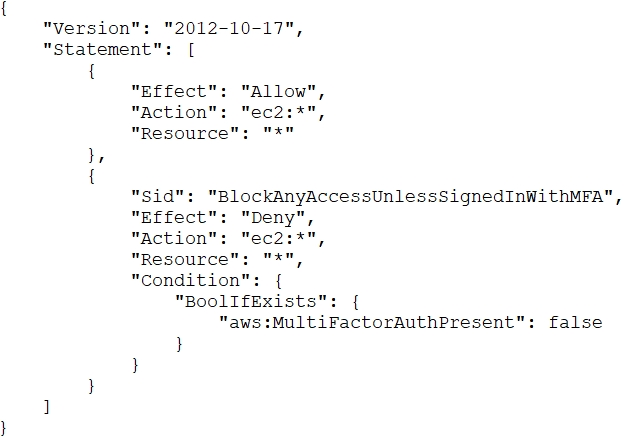A company is designing the security architecture for a global latency-sensitive web application it plans to deploy to AWS. A security engineer needs to configure a highly available and secure two-tier architecture. The security design must include controls to prevent common attacks such as DDoS, cross-site scripting, and
SQL injection.
Which solution meets these requirements?
B
A company is using AWS Organizations to manage multiple AWS accounts. The company has an application that allows users to assume the AppUser IAM role to download files from an Amazon S3 bucket that is encrypted with an AWS KMS CMK. However, when users try to access the files in the S3 bucket, they get an access denied error.
What should a security engineer do to troubleshoot this error? (Choose three.)
BDE
A city is implementing an election results reporting website that will use Amazon CloudFront. The website runs on a fleet of Amazon EC2 instances behind an
Application Load Balancer (ALB) in an Auto Scaling group. Election results are updated hourly and are stored as .pdf files in an Amazon S3 bucket. A security engineer needs to ensure that all external access to the website goes through CloudFront.
Which solution meets these requirements?
C
Which of the following are valid configurations for using SSL certificates with Amazon CloudFront? (Choose three.)
ACD
An AWS account administrator created an IAM group and applied the following managed policy to require that each individual user authenticate using multi-factor authentication:
After implementing the policy, the administrator receives reports that users are unable to perform Amazon EC2 commands using the AWS CLI.
What should the administrator do to resolve this problem while still enforcing multi-factor authentication?
B
A recent security audit identified that a company's application team injects database credentials into the environment variables of an AWS Fargate task. The company's security policy mandates that all sensitive data be encrypted at rest and in transit.
Which combination of actions should the security team take to make the application compliant with the security policy? (Choose three.)


AEF
A security engineer is responsible for providing secure access to AWS resources for thousands of developers in a company's corporate identity provider (IdP). The developers access a set of AWS services from their corporate premises using IAM credentials. Due to the volume of requests for provisioning new IAM users, it is taking a long time to grant access permissions. The security engineer receives reports that developers are sharing their IAM credentials with others to avoid provisioning delays. This causes concern about overall security for the security engineer.
Which actions will meet the program requirements that address security?
B
Reference:
https://docs.aws.amazon.com/IAM/latest/UserGuide/id_roles_common-scenarios_federated-users.html
A company hosts an application on Amazon EC2 that is subject to specific rules for regulatory compliance. One rule states that traffic to and from the workload must be inspected for network-level attacks. This involves inspecting the whole packet.
To comply with this regulatory rule, a security engineer must install intrusion detection software on a c5n.4xlarge EC2 instance. The engineer must then configure the software to monitor traffic to and from the application instances.
What should the security engineer do next?
C
A company's security officer is concerned about the risk of AWS account root user logins and has assigned a security engineer to implement a notification solution for near-real-time alerts upon account root user logins.
How should the security engineer meet these requirements?
B
Reference:
https://aws.amazon.com/blogs/mt/monitor-and-notify-on-aws-account-root-user-activity/
A company wants to encrypt data locally while meeting regulatory requirements related to key exhaustion. The encryption key can be no more than 10 days old or encrypt more than 2^16 objects. Any encryption key must be generated on a FIPS-validated hardware security module (HSM). The company is cost-conscious, as it plans to upload an average of 100 objects to Amazon S3 each second for sustained operations across 5 data producers.
Which approach MOST efficiently meets the company's needs?
C